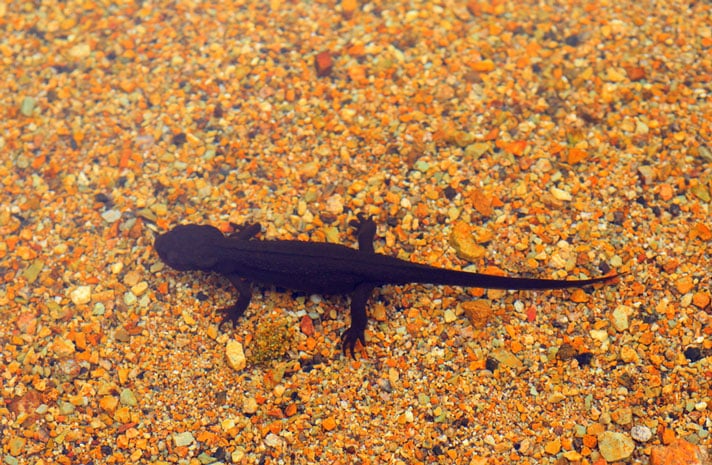Japanese fire-bellies are easier to acquire as captive bred offspring from other hobbyists.
Japanese Fire-Bellied Newt (Cynops pyrrhogaster)
These newts are native to the islands of Japan. Their skin is coarse and granular, and they have prominent disc-shaped parotoid glands behind the head, which can secrete distasteful chemicals if a predator bites the newt. While their back and sides are brown in color, they get their name from their bright orange belly. The belly is frequently spotted with white dots or larger brown markings. Other Asian newts can have orange bellies too, so don’t rely on this alone to identify fire-bellied newts.
Japanese Fire-Bellied Newt Availability
Wild caught fire-bellied newts are often available in the pet trade, but these are usually the smaller, more delicate species, the Chinese Fire-Belly, Cynops orientalis. Japanese Fire-Bellies are easier to acquire as captive bred offspring from other hobbyists. Search internet forums or contact amphibian specialists at reptile shows to acquire them. Choose large, bold, brightly colored and well-fed specimens, with bright, unclouded eyes. These newts rarely cost more than $20 each.
Read More
Breeding Chinese Fire-Bellied Newts
Japanese Fire-Bellied Newt Size
They are medium sized newts, reaching 4-6 inches in total length. Young juveniles may be less than 2 inches in length. Older newts are more aquatic and easier to keep, so try to acquire larger specimens if possible.
Japanese Fire-Bellied Newt Lifespan
These newts can live for 3 decades or more, but 10 years is a reasonable age in captivity with proper husbandry and newt supplies.
Japanese Fire-Bellied Newt Housing
A 20 gallon aquarium is adequate for 2 pairs of newts. These newts will live happily in a fully aquatic setup, but be sure to provide a platform or island onto which they can crawl should they wish to leave the water. Tap water should be treated with aquarium dechlorinator, and 20% water changes should be carried out every 1-2 weeks.
Aquarium sand or reptile gravel make good newt bedding. The newts will enjoy lots of live aquarium plants such as Egeria, Cabomba and Amazon Sword. An aquarium filter can be used, but these newts are still water animals. So keep filter water flow to a minimum if possible. Special amphibian packages that include structures and filters for larger gallon tanks are available such as the Tetrafauna Viquarium Terrarium and Aquarium
Japanese Fire-Bellied Newt Lighting and Temperature
These newts do not tolerate extremes of temperature well, so keep their aquarium between 60 and 75 F for most of the year. Cold temperatures are easily avoided by using an aquarium heater set on its lowest setting.
Fire-bellies do not require lighting, but if you wish to keep aquatic plants with your newts, which they will appreciate, then you will need a freshwater spectrum light, such as those sold for fish aquariums. Don’t forget a tight fitting lid with cage locks because these newts are excellent escape artists.
Japanese Fire-Bellied Newt Food
Chopped live nightcrawlers or frozen bloodworm cubes are good staple foods. Feed 1 chopped nightcrawler or 1 cube of frozen bloodworms per 4 newts every 2 days.
John Clare is the founder of Caudata.org and Frogforum.net.


